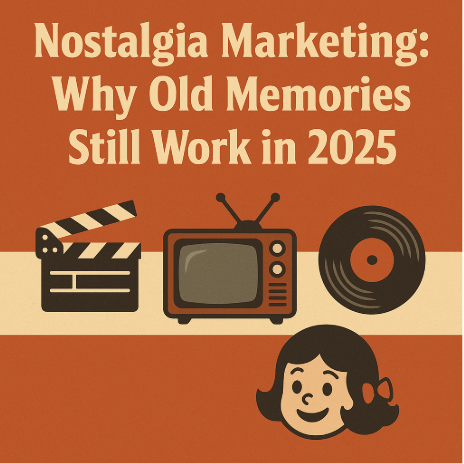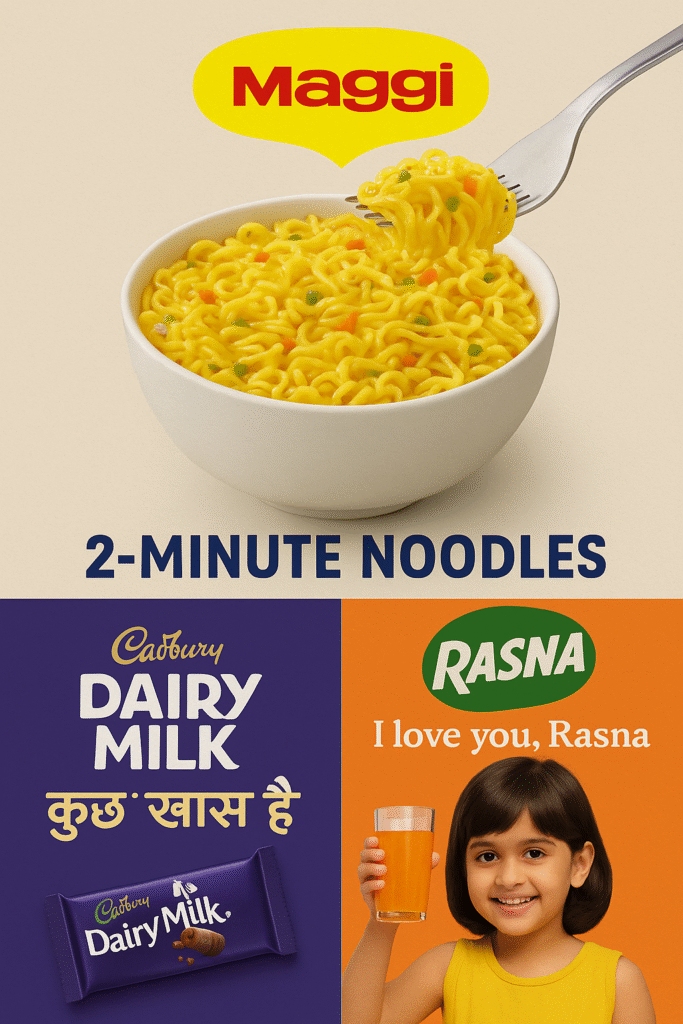
- What Is Nostalgia marketing?
Ironically, a few seconds of an old jingle can bring you back 15 years like it just happened yesterday. That’s nostalgia — and we may not like it, but it gets us. Nowadays, brands have learned how to tap into that very feeling to reach out to us. Not with grand offers or advanced ads, but with feelings. And to be honest? It does work.
- Emotions Over Features
Let’s be honest — humans are sick of being pitched something every other second. You’re browsing your phone, and there’s an ad for everything: shoes, apps, food, classes, you name it. But what stops you and makes you feel something? A memory. That’s where nostalgia comes in.
Whether the chocolate bar contains the same ingredients or not doesn’t matter — if it takes you back to exam days or school vacations, you’re more likely to purchase it again. Not due to the item itself, but due to the feeling it evokes.
- Brands Who Got It Right
Chances are, you’ve noticed a couple of ads lately that seemed quite familiar. That’s not an accident — it’s intentional.
Maggi is still referred to as the “2-minute noodles,” although we all realise it takes more time. But nobody cares. It brings back memories of midnight hostel pangs or instant meals when we were too lazy to make something ourselves.
Cadbury Dairy Milk revived its “Kuch Khaas Hai” campaign with a new variant. It was not the same commercial, but the essence? Remained the same.
Rasna —aye, the very Rasna — revived their retro slogan and even resurrected the vintage kid star. Before long, everyone craved orange-flavoured water once more.
And, naturally, Amul. Their cartoon girl just doesn’t seem to fade away, telling jokes and providing us with the same retro feels we grew up gawking at billboards.

- Social Media Role In Nostalgia
Social media has contributed significantly to the rise of nostalgia. People on Instagram are posting images of vintage packaging, jingles are being remixed into reels, and 90s ads are reaching more viewers today than they ever reached in the past.
Even younger people who never got to see these ads in their lives are living with them. That’s the thing, you don’t have to be included in a memory for you to get it. Sometimes, just seeing or hearing it makes you feel something.
- Merging The Past With The Present
Here’s the secret: simply bringing back yesterday isn’t sufficient. Not all brands bomb because they bring back yesterday; some bring it back and fail to integrate it into today’s reality. The greatest campaigns strike a balance.
A ’90s jingle could be more effective if it were remixed with the current beats. Or a retired mascot could relate better if they’re featured in a meme. When brands find the essence of the past and mix it with the coolness of the present, that’s when nostalgia settles in.
- Final thoughts
Nostalgia marketing is not about fooling people — it’s about reminding them to stand still for a moment and think back. In a world that’s always speeding up, it brings a piece of the past back that makes them smile. It’s not marketing, it’s an opportunity to re-remember who they used to be, and that’s something special.
And if a brand can make you feel that way? That’s more compelling than any ad script or gaudy slogan.
FAQ: Nostalgia Marketing in 2025
1. What is nostalgia marketing and how does it work?
Nostalgia marketing is a strategy where brands use emotional memories from the past to connect with customers today. It works by reminding people of meaningful experiences, making them feel good — and more likely to engage or purchase.
2. Why is nostalgia marketing so powerful in 2025?
In a fast-paced digital world filled with endless scrolling and overstimulation, nostalgia marketing gives people something emotionally grounding. In 2025, it brings comfort, a sense of identity, and familiarity — things consumers crave now more than ever.
3. What’s the difference between nostalgic advertising and nostalgia marketing?
Nostalgic advertising refers to specific visuals, jingles, or slogans that remind viewers of the past. Nostalgia marketing, on the other hand, is a broader, strategic approach that uses those elements to tell a story and build a long-term brand connection.
4. Which Indian brands have used nostalgia advertising successfully?
Some iconic examples include:
Maggi – reminding viewers of childhood snacks and lunch breaks
Cadbury Dairy Milk – emotional ads about sharing and festivals
Amul – timeless cartoon strips and dairy slogans
Rasna – classic “I love you Rasna” campaign from the ’90s
5. Can nostalgia marketing help boost product sales?
Absolutely. It creates emotional trust, which often leads to higher engagement and repeat purchases. If a campaign makes people smile or triggers a memory, they’re more inclined to buy based on that connection, not just product features.
6. Is nostalgia marketing only effective for older generations?
Not at all. Gen Z and younger millennials also respond well to retro themes. Through social media and pop culture, they’re exposed to past decades — and that second-hand nostalgia still creates a powerful emotional effect.
7. How does nostalgia marketing perform on platforms like Instagram or YouTube?
It thrives. Vintage content, recreated ads, retro filters, and old songs remixed into Reels or Shorts often go viral. These platforms let brands reach younger audiences with older emotional cues, creating a perfect blend of past and present.
8. Can small businesses benefit from nostalgia marketing?
Yes! You don’t need a giant budget. Small businesses can revive old logos, use retro packaging, or tell stories about how things “used to be.” This can evoke shared memories within their local or niche audience, making them feel more connected.
9. What are some common mistakes in nostalgia marketing?
Relying too much on the past without making it relevant today. Some brands dig up old ads or taglines but fail to contextualize them for modern consumers. It’s crucial to balance familiarity with freshness.
10. How can brands measure success in nostalgia marketing?
Emotional engagement is a key indicator. Watch for audience reactions like comments (“This takes me back!”), shares, and long view times. Surveys, sentiment analysis, and return purchase data also help measure long-term brand impact.
11. How do global brands apply nostalgia marketing differently than Indian brands?
Global brands like Nike or McDonald’s often revive older styles, packaging, or mascots but fuse them with modern branding. For instance, Nike reintroduces retro shoes with new tech, keeping both the emotional and functional appeal alive.
12. Can nostalgia marketing backfire if not done properly?
Yes. If it feels forced or disconnected from the audience, it can come across as pandering. For example, using a retro reference nobody remembers — or one with negative connotations — can weaken trust instead of building it.
13. Is nostalgia marketing better for physical products or services?
It works well for both. A physical product (like a candy brand) may tap into childhood flavors, while a service (like a theme park or travel agency) can recreate retro experiences. The key is emotional storytelling — not the medium.
14. What makes nostalgia marketing authentic rather than gimmicky?
Authenticity lies in relevance. If the memories you’re evoking are genuinely shared by your audience, and you’re not just jumping on a trend, people feel it. It’s about evoking shared cultural or generational moments — not random callbacks.
15. Can nostalgia marketing be seasonal or event-based?
Definitely. Many brands use nostalgia around festivals, school exam seasons, or even specific years (like Y2K or 90s themes). Event-based nostalgia works great because people are already emotionally primed during those times.
16. How do memes contribute to nostalgia marketing?
Memes act as modern nostalgia triggers. A meme using 2000s cartoon characters or old-school Bollywood references can instantly transport users back in time. They’re shareable, relatable, and give brands viral exposure when done right.
17. What role do influencers play in nostalgia marketing?
Influencers can revive retro trends or products, often introducing them to new generations. A creator showing off their old Nokia phone or recreating a childhood lunchbox snack sparks cross-generational appeal and builds curiosity among younger viewers.
18. Can nostalgia marketing be localized?
Yes. In fact, regional nostalgia is powerful. A brand might highlight 90s Doordarshan serials in India or traditional sweets packaging — things that deeply resonate with a specific geographic or cultural audience.
19. What industries benefit the most from nostalgia marketing?
Food & Beverage, Fashion, Entertainment, and Tech (especially retro gaming) are all ideal candidates. But any industry with a legacy or emotional product history can use it — even insurance or banking, if done creatively.
20. How can emerging startups use nostalgia marketing effectively?
Startups can revive discontinued styles, offer retro-styled packaging, or simply tell emotional origin stories tied to older values. A simple nod to “how grandma used to do it” or “90s inspiration” goes a long way in building emotional trust
Penned by Vani sahu
Edited by Shashank Khandelwal, Research Analyst
For any feedback mail us at [email protected]
Transform Your Brand's Engagement with India's Youth
Drive massive brand engagement with 10 million+ college students across 3,000+ premier institutions, both online and offline. EvePaper is India’s leading youth marketing consultancy, connecting brands with the next generation of consumers through innovative, engagement-driven campaigns. Know More.
Mail us at [email protected]
Penned by Names
Edited by Ritika Sharma, Research Analyst
For any feedback mail us at [email protected]
Transform Your Brand's Engagement with India's Youth
Drive massive brand engagement with 10 million+ college students across 3,000+ premier institutions, both online and offline. EvePaper is India’s leading youth marketing consultancy, connecting brands with the next generation of consumers through innovative, engagement-driven campaigns. Know More.
Mail us at [email protected]
Penned by Vani sahu
Edited by Shashank Khandelwal, Research Analyst
For any feedback mail us at [email protected]
Transform Your Brand's Engagement with India's Youth
Drive massive brand engagement with 10 million+ college students across 3,000+ premier institutions, both online and offline. EvePaper is India’s leading youth marketing consultancy, connecting brands with the next generation of consumers through innovative, engagement-driven campaigns. Know More.
Mail us at [email protected]